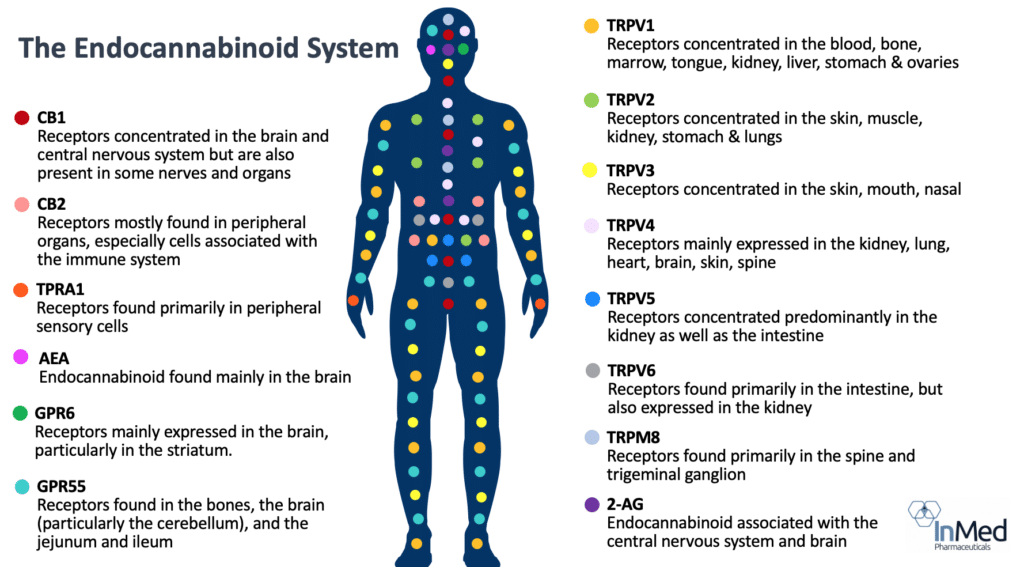INM-089 for Age-Related Macular Degeneration
INM-089 is a small molecule drug candidate being studied for its potential as a treatment for age-related macular degeneration (AMD).
Study shows that INM-089 improved retinal function and thickness of the retina
InMed has selected INM-089, a small molecule drug candidate, for further preclinical development. Recent preclinical studies of INM-089 demonstrated significant functional and pathological improvements in an AMD disease study model.
Results from several in vitro and in vivo studies demonstrate INM-089’s pharmacological effects in the potential treatment of dry AMD, as summarized:
- INM-089 provides neuroprotection of photoreceptors and improves photoreceptor function
- INM-089 improves the integrity of the retinal pigment epithelium (RPE)
- INM-089 reduces extracellular autofluorescent (AF) deposits, a hallmark of dry AMD
- INM-089 preserves retinal function in the back of the eye
- INM-089 improves thickness of “outer nuclear layer” (ONL) of the retina where photoreceptors are located.
Based on widely accepted ocular research, the thickness of the outer nuclear layer is strongly correlated with photoreceptor preservation and visual acuity.
INM-089 shows promising neuroprotective effects for age-related macular degeneration
INM-089 has demonstrated its ability to proactively protect the nerve cells in the back of the eye in the retinal area, exhibiting its therapeutic potential in age-related macular degeneration (AMD).
INM-089 shows promising neuroprotective effects in the back of the eye, which may lead to the preservation of the retinal function. Neuroprotection in AMD remains an unmet medical need and a new treatment option addressing neuroprotection may help to eliminate or reduce the effects resulting from this multifactorial disease.
InMed studied and compared the effects of several rare cannabinoids and cannabinoid analogs on various eye disease models. INM-089 emerged as a promising small molecule drug candidate for dry AMD.


INM-089 demonstrates improved retinal pigment epithelium integrity
One of the hallmarks of age-related macular degeneration is the deposits of drusen, which is secreted by the retinal epithelium pigment (RPE) cells and can damage the integrity of the macula or back of the eye responsible for central vision. Most people over the age of 60 will have levels of drusen deposits. Hard drusen are small with well-defined borders and are associated with a lower risk of developing into AMD, whereas soft drusen are larger and cluster together and are associated with a higher risk of developing late-stage AMD, also known as geographic atrophy. Over time, soft drusen can lead to RPE detachments and damage the outer retina and cause central vision loss.
In an in vivo study conducted by InMed, it was demonstrated that INM-089 reduced extracellular autofluorescent (AF) deposits, including drusen.
INM-089 is a small molecule compound acting as a selective dual CB1 & CB2 agonist
INM-089 is a preferential signaling agonist of cannabinoid receptor 1 (CB1) and cannabinoid receptor 2 (CB2).
CB1 and CB2 receptors are both part of the endocannabinoid system and are found throughout the body and are responsible for many homeostatic functions. CB1 receptors are primarily located in the brain and central nervous system, while CB2 receptors are involved in modulating neuroinflammation and immune responses.
Activation of CB1 and CB2 receptors has been shown to have neuroprotective effects and protect cells from damage and death.
INM-089 is a small molecule compound. Small molecules can cross the blood-brain barrier and are typically better suited for multiple drug delivery options, making it a promising drug candidate for pharmaceutical use.
Small-molecule drugs have several advantages that contribute to their widespread use such as flexible oral administration, an ability to be efficiently absorbed by the body and storage and transport stability.


INM-089 AMD effects discovered in glaucoma preclinical studies
INM-089 is the second ocular program to be developed by InMed. The pharmacological effects of INM-089 in the back of the eye were discovered while conducting preclinical studies of InMed’s glaucoma drug candidate INM-088.
In was during this research of INM-088 when InMed scientists observed the ability of a cannabinol analog, now INM-089, to proactively protect the nerve cells in the back of the eye. As a result of this discovery, InMed launched INM-089 for the potential treatment of AMD.
While INM-088 demonstrated positive effects for the potential treatment of glaucoma, InMed will use it resources to pursue its advancement of its INM-089 program in AMD.
Why cannabinoids for ocular disease?
Mounting scientific research is pointing to the neuroprotective effects of cannabinoids, supporting its therapeutic potential in ocular diseases such as AMD and glaucoma, in which neuroprotection is key to preserving the nerve cells in the eyes and potentially slowing or reversing eye damage. Several preclinical studies conducted by InMed in three of its programs have consistently shown the neuroprotective effects of cannabinoids in well-recognized study models.


What is Age-related Macular Degeneration?
Age-related macular degeneration (AMD) is an eye disease that causes damage to the macula which is part of the retina at the back of the eye. The macula controls the sharp vision straight ahead of you, and damage to the macula affects a person’s central vision.
AMD is common amongst the elderly and is a leading cause of vision loss. While it does not cause complete blindness, those with AMD will find it difficult to read, drive or do simple things around the home.
There two primary types of AMD – dry AMD and wet AMD.
Dry AMD is the most common form of AMD, accounting for 80% of AMD cases. Dry AMD typically takes several years to progress and happens in three stages. The advanced stage of dry AMD is also referred to as as geographic atrophy (GA). InMed’s INM-089 is being studied for dry AMD.
Learn more about AMD, its causes, prevalence and prevention.





